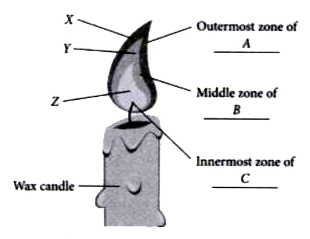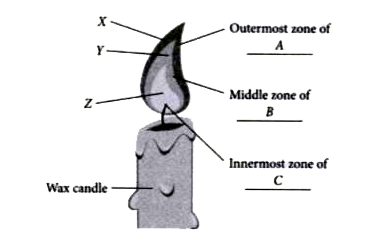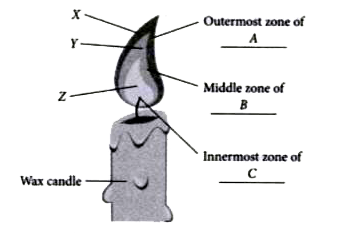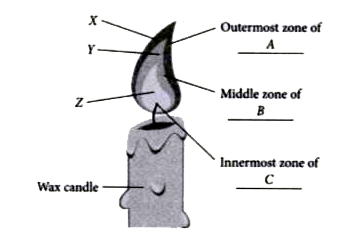What type of substances, on burning, give a flame ?
To answer the question, "What type of substances, on burning, give a flame?", we can break down the solution into clear steps:
1. Understanding Combustion:
- Combustion is a chemical reaction that occurs when a substance reacts with oxygen, releasing energy in the form of heat and light.
2. Identifying Flame-Producing Substances:
- Not all substances produce a flame when burned. The substances that do are typically those that can vaporize during the combustion process.
3. Examples of Flame-Producing Substances:
- Kerosene Oil: When kerosene oil is heated, it vaporizes. The vapor then burns in the presence of oxygen, producing a flame.
- Molten Wax: Similar to kerosene, when wax is heated (for example, in a candle), it melts and the molten wax rises through the wick. As it burns, it vaporizes and produces a flame.
4. Conclusion:
- Substances that can vaporize during burning, such as kerosene oil and molten wax, are examples of materials that produce a flame when they combust.
Final Answer:
Substances that give a flame upon burning are those that vaporize during the combustion process, such as kerosene oil and molten wax.
---
- Combustion is a chemical reaction that occurs when a substance reacts with oxygen, releasing energy in the form of heat and light.
- Not all substances produce a flame when burned. The substances that do are typically those that can vaporize during the combustion process.
- Kerosene Oil: When kerosene oil is heated, it vaporizes. The vapor then burns in the presence of oxygen, producing a flame.
- Molten Wax: Similar to kerosene, when wax is heated (for example, in a candle), it melts and the molten wax rises through the wick. As it burns, it vaporizes and produces a flame.
- Substances that can vaporize during burning, such as kerosene oil and molten wax, are examples of materials that produce a flame when they combust.
Substances that give a flame upon burning are those that vaporize during the combustion process, such as kerosene oil and molten wax.
Topper's Solved these Questions
Similar Questions
Knowledge Check
A flame is the visible gaseous part of a fire. It is a zone of combustion of gaseous substances accompanied by evolution of heat and light. All substances do not burn with a flame. Only those substances that vaporise during burning produce flame. A candle flame is taken to study the various zones of a flame.

The luminous and non-luminous zones of flame is respectively.AOutermost, middle zoneBInnermost, outermost zoneCMiddle, outermost zoneDOutermost, innermost zoneA flame is the visible gaseous part of a fire. It is a zone of combustion of gaseous substances accompanied by evolution of heat and light. All substances do not burn with a flame. Only those substances that vaporise during burning produce flame. A candle flame is taken to study the various zones of a flame.

Which zone of a candle flame is the zone of no combustion?AOutermost zoneBMiddle zoneCInnermost zoneDNone of theseA flame is the visible gaseous part of a fire. It is a zone of combustion of gaseous substances accompanied by evolution of heat and light. All substances do not burn with a flame. Only those substances that vaporise during burning produce flame. A candle flame is taken to study the various zones of a flame.

Arrange X, Y and Z in increasing order of temperature.AX<Y<ZBZ<Y<XCZ<X<YDY<Z<X
What tyupe of fuels:
(a) burn with a flame?
(b)burn without a flame?
View SolutionWhy some substances burn with a flame while as some burn without a flame?
View SolutionThe substance that does not burn with flame is
View SolutionA flame is the visible gaseous part of a fire. It is a zone of combustion of gaseous substances accompanied by evolution of heat and light. All substances do not burn with a flame. Only those substances that vaporise during burning produce flame. A candle flame is taken to study the various zones of a flame.

(A), (B) and (C) are respectively.
View SolutionA flame is the visible gaseous part of a fire. It is a zone of combustion of gaseous substances accompanied by evolution of heat and light. All substances do not burn with a flame. Only those substances that vaporise during burning produce flame. A candle flame is taken to study the various zones of a flame.

Different zones of a candle flame are marked by the letters (A), (B) and (C).
Which of the following statements are correct?
(I) (B) is the hottest part of the flame.
(II) (C) is moderately hot.
(III) (A) is the hottest part of the flame.
(IV) (A) is moderately hot whereas (C) is the coldest part.
(V) (C) is the luminous zone.
(VI) (B) is the luminous zone.
(VII) (A) is the dark zone.
View Solution
